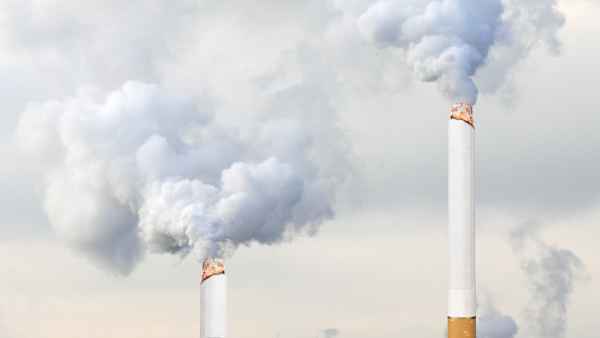Is Smoking Cigarettes Bad for the Environment?
23rd May 2024


How Bad is Smoking Cigarettes for the Environment?
If you’ve ever seen those anti-smoking ads with the lungs looking like a used teabag and thought, “Blimey, that's grim,” brace yourself. Turns out, it’s not just your insides that get wrecked by smoking. Lighting up a cigarette is like launching a tiny, fiery missile at the environment.
Who knew that something so small could cause such a big mess? So, buckle up, because we’re about to take a smoke-filled journey through the many ways that cigarettes are giving Mother Earth a serious case of smoker’s cough.

The Life Cycle of a Cigarette: From Seed to Smog
Let’s start at the very beginning, a very good place to start (thanks, Julie Andrews). The journey of a cigarette begins in the fields where tobacco is grown. These fields aren't just any old patches of land. No, they’re vast, thirsty, and hungry for all the resources they can get.
Tobacco Farming: Sucking the Life Out of the Land
Tobacco plants might look all innocent and leafy, but don’t be fooled. Growing these bad boys is like having a demanding pet that never stops asking for food and water. Tobacco farming is notoriously resource-intensive. It chugs water like there’s no tomorrow (around twenty-two Billion Tonnes) and demands a cocktail of pesticides and fertilisers that would make Alan Titchmarsh weep.
But wait, there’s more! The chemicals used in tobacco farming often leach into the soil and water systems, causing all sorts of havoc. It’s like when you accidentally spill coffee on your mate’s favourite white shirt, but worse, because it affects entire ecosystems. Soil degradation and water pollution become the unfortunate side effects of our leafy addiction.
Deforestation: Clearing the Air (Literally)
Tobacco needs curing before it makes its way into that shiny pack in your pocket. Curing involves drying the leaves, and this often requires wood-fired kilns. Enter deforestation. To fuel these kilns, vast amounts of trees are chopped down. We’re talking about serious tree-murder here. In some parts of the world, tobacco curing is a major cause of deforestation.

Manufacturing: Factories of Fumes
After the tobacco is cured, it heads to the factory where it’s rolled into cigarettes. Factories are generally not known for their eco-friendly vibes, and cigarette factories are no different. The manufacturing process is energy-intensive and produces significant waste, including chemical by-products that are about as friendly as a crocodile in a bad mood.
Packaging: Wrapping Up the Problem
Cigarettes are then packaged in cardboard, foil, and plastic. Have you ever opened a pack and noticed all those layers? It’s like a tiny, cancerous Russian doll. This packaging, while necessary to keep the cigarettes fresh (because who doesn’t love a fresh stick of poison?), adds to the mounting pile of waste. Much of this packaging is not recycled, ending up in landfills where it sits around for decades, like a bad guest who just won’t leave.

Lighting Up: Pollution on Fire
So, you’ve got your cigarette. Now what? You light it up, and suddenly you’re releasing a cocktail of toxic chemicals into the air. Delightful. The smoke from cigarettes contains more than 7,000 chemicals, many of which are harmful not just to humans, but to the environment as well.
Air Pollution: Puffing Out Poisons
When you smoke, you're essentially creating your own mini-industrial revolution, complete with air pollution. Cigarette smoke contains a variety of pollutants, including carbon monoxide, ammonia, and formaldehyde. These nasties contribute to air pollution and can linger in the atmosphere, affecting both indoor and outdoor air quality.
Second-Hand Smoke: Sharing is Not Caring
Second-hand smoke doesn’t just hang around being unpleasant; it’s actively harmful. Not only is it bad news for your family, friends other humans who breathe it in, but it also contributes to the overall pollution levels. Imagine sitting next to a barbecue that never stops belching out smoke, and you get the idea.

The End of the Line: Butt Litter
Once the cigarette is done, you’re left with a cigarette butt. Ah, the infamous cigarette butt. These little devils are everywhere. Walk down any street, beach, or park, and you’re likely to see them scattered about like tiny, toxic breadcrumbs.
Litter: Not Just an Eyesore
Cigarette butts are the most littered item in the world. Yes, you read that right. Those tiny filters are made of cellulose acetate, a type of plastic that takes years, if not decades, to break down. And as they break down, they release microplastics and chemicals into the environment, contaminating soil and water. It’s like a gift that keeps on giving, but in the worst possible way.
Marine Life: Fish Don’t Smoke
Cigarette butts often end up in our waterways. Once there, they’re ingested by marine life. Fish, turtles, and birds mistake them for food, and eating these toxic titbits can be fatal. Imagine going for a swim and having a snack, only to find out your snack is a tiny, poisonous piece of plastic. Not exactly appetising, right?
The Bigger Picture: Climate Change and Beyond
Cigarette smoking doesn’t just impact the immediate environment; it plays a part in the larger issue of climate change.
Greenhouse Gases: Adding Fuel to the Fire
The production and consumption of tobacco contribute to the emission of greenhouse gases. From the carbon dioxide released during tobacco farming and deforestation to the methane and nitrous oxide from cigarette smoke, it’s all adding up. While smoking might seem like a tiny blip in the grand scheme of things, every little bit counts in the fight against climate change.
Resource Depletion: Smoking Away Our Future
The resources used in tobacco farming, manufacturing, and distribution are significant. Water, land, and energy are all consumed at alarming rates to support the tobacco industry. These are resources that could be better used to support sustainable practices and address food security issues. Instead, we’re effectively burning through them, quite literally, for a habit that’s not just deadly for us but also for the planet.

What Can We Do? Kicking the Habit for a Greener Planet
Now that we've established just how bad smoking is for the environment, what can we do about it? The obvious answer is to stop smoking. Easier said than done, right? But quitting smoking isn't just good for your health; it’s a step towards a healthier planet too.
Reduce and Recycle: Minimising the Impact
For those who aren’t ready to quit, there are still ways to reduce the environmental impact. Properly disposing of cigarette butts by using designated bins and encouraging recycling programs can help. Some innovative companies are even finding ways to recycle cigarette waste into useful products. It’s not a perfect solution, but it’s a start.
Support Sustainable Alternatives: Go Green
Supporting and advocating for sustainable farming practices within the tobacco industry can also make a difference. Reducing the use of harmful pesticides, conserving water, and protecting forests are steps that can mitigate some of the environmental damage caused by tobacco production.
Educate and Advocate: Spread the Word
Education is key. By spreading awareness about the environmental impact of smoking, we can encourage more people to make greener choices. Advocacy for stronger regulations on tobacco production and waste management can also drive change on a larger scale.
A Future Without Cigarette Pollution
Imagine a world where cigarette butts aren’t littering the streets, where forests aren’t cut down to dry tobacco leaves, and where the air is a little cleaner because fewer people are puffing away. It’s a world that’s healthier not just for us, but for every living thing that shares this planet with us.
Quitting smoking might be one of the hardest things a person can do, but it’s also one of the most impactful actions for personal health and the environment. And who knows? Maybe one day, we’ll look back at smoking cigarettes the same way we look at using leaded petrol or dumping rubbish in the streets: as a relic of a less enlightened time.
So next time you think about lighting up, remember that it’s not just your lungs you’re hurting. It’s the fields where the tobacco was grown, the trees that were cut down, the air we all breathe, and the oceans where cigarette butts end up. Your choice to smoke (or not) has ripple effects far beyond your own health. For the sake of our planet, it might just be time to stub out that cigarette for good.
In conclusion, while smoking is undeniably bad for your health, it’s also terrible for the environment. From deforestation and pollution to litter and climate change, the impacts are far-reaching. By understanding and addressing these issues, we can take steps towards a healthier future for ourselves and our planet. So, let’s all do our part to kick the habit and breathe a little easier – literally and metaphorically.
About V2 UK
V2 UK has over 12 years of experience in helping smokers to choose a smarter alternative to smoking.
For more information and support on quitting smoking, visit our Smarter Alternative Hub Page.
Read our disclaimer on Vaping and Smoking Cessation
Environmental Resources
Tobacco and the Environment (ASH)
Tobacco Industry environment Impact (World Health Organisation)
Stop Smoking Resources
Vaping to Quit Smoking Advice from the NHS
